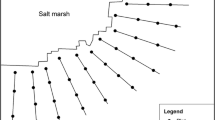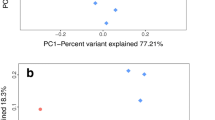Abstract
We evaluated the response of the Antarctic soil nematodes Scottnema lindsayae and Plectus antarcticus to various salts (NaCl, MgSO4, KNO3 and NaCl + MgSO4) and salt concentrations in prepared salt solutions ranging from 0.1 to 3 M, and in saturation paste extracts of soils collected from multiple locations where nematode abundance varied from zero to numerous, and where electrical conductivity ranged from 108 to >12,000 μS/cm. Nematode salt tolerance was salt specific; both nematode species survived in low-experimental concentrations of NaCl and MgSO4, and neither species survived in KNO3 solutions of any concentration. There was no survival of nematodes in the saturation paste extracts of highly saline soils (4,100 μS/cm), while survival was over 80–97% in less saline soils (1,945 μS/cm). A 1:1 dilution of these highly saline saturation paste extracts increased S. lindsayae survival to 80%, while survival of P. antarcticus was not observed until dilutions of greater than 200%. The results complement previous studies demonstrating niche partitioning of S. lindsayae and P. antarcticus across salinity gradients and strengthen interpretations of the physiological mechanisms underlying previously reported spatial correlation between soil salinity and nematodes abundance in the Antarctic Dry Valleys.



Similar content being viewed by others
References
Bamforth SS, Wall DH, Virginia RA (2005) Distribution and diversity of soil protozoa in McMurdo Dry Valleys, Antarctica. Polar Biol 28:756–762
Barrett JE, Virginia RA, Wall DH (2002) Trends in resin and KCl-extractable soil nitrogen across landscape gradients in Taylor Valley, Antarctica. Ecosystems 5:289–299
Barrett JE, Wall DH, Virginia RA, Parsons AN, Powers LE, Burkins MB (2004) Biogeochemical parameters and constraints on the structure of soil biodiversity. Ecology 85:3105–3118
Beyer L, Bockheim JG, Campbell IB, Claridge GGC (1999) Genesis, properties and sensitivity of Antarctic Gelisols. Antarct Sci 11:387–398
Blake CD (1961) Importance of osmotic potential as a component of the total potential of the soil water on the movement of nematodes. Nature 19:144–145
Bockheim JG (1995) Permafrost distribution in the Southern Circumpolar Region and its relation to the environment: a review and recommendations for further research. Permafrost Periglacial Proc 6:27–45
Bockheim JG. (1997) Properties and classification of cold desert soils from Antarctica. Soil Sci Soc Am J 61:224–231
Campbell IB, Claridge GGC (1987) Soils and the environment. In: Antarctica: soils, weathering processes and environment. Development in soil science, vol 16. Elsevier, New York, pp 329–340
Campbell IB, Claridge GGC (2000) Soil temperature, moisture and salinity patterns in transantarctic mountain cold desert ecosystems. In: Davison W, Howard-Williams C, Broady P (eds) Antarctic ecosystems: model for wider ecological understanding. NZ Natural Sciences, pp 233–240
Campbell IB, Claridge GGC, Campbell DI, Balks MR (1998) The soil environment of the McMurdo Dry Valleys, Antarctica. In: Priscu JC (ed) Ecosystem dynamics in a polar desert: The McMurdo Dry Valleys, Antarctica. Antarctic Research Series 72 AGU, Washington, DC, pp 297–322
Claridge GGC, Campbell IB (1968) Origin of nitrate deposits. Nature 217:428–430
Claridge GGC, Campbell IB (1977) The salts in Antarctic soils, their distribution and relationship to soil processes. Soil Sci 123:377–384
Convey P. (1996) The influence of environmental characteristics on life history attributes on Antarctic terrestrial biota. Biol Rev 71:191–225
Cooper AF, Van Gundy SD (1971) Senescence, quiescence and cryptobiosis. In: Zuckerman BM, Mai WF, Rohde RA (eds) Plant parasitic nematodes, cytogenesis, host-parasite interactions, and physiology. Academic, New York, pp 297–315
Courtright EM, Wall DH, Virginia RA (2001) Determining habitat suitability for soil invertebrates in an extreme environment: The McMurdo Dry Valleys, Antarctica. Antarct Sci 13:9–17
Cowan DA, Tow LA (2004) Endangered Antarctic environments. Ann Rev Microbiol 58:649–690
Davey KC (1995) Water, water compartments and water regulation in some nematodes parasitic in vertebrates. J Nematol 27:433–440
Demeure Y, Freckman DW, Van Gundy SD (1979) Anhydrobiotic coiling of nematodes in soil. J Nematol 11:189–195
Doran PT, Priscu JC, Lyons WB, Walsh JE, Fountain AG, McKnight DM, Moorhead DL, Virginia RA, Wall DH, Clow GD, Fritsen CH, McKay CP, Parsons AN (2002) Antarctic climate cooling and terrestrial ecosystem response. Nature 415:517–520
Ellis-Evans JC (1997) Micro-scale distribution of phytoautotropic micro-organisms in relation to light, temperature and moisture in Antarctic lithosols. In: Lyons WB, Howard-Williams C, Hawes I (eds) Ecosystem processes in antarctic ice-free landscapes. Balkema, Rotterdam, pp 89–102
Fogg GE (1998) The biology of polar habitats. Oxford University Press, New York
Foreman CM, Wolf CF, Priscu JC (2004) Impact of episodic warming events on the physical, chemical and biological relationships of lakes in the McMurdo Dry Valleys, Antarctica. Aquatic Geochem 10:239–268
Forster SJ (1998) Osmotic stress tolerance and osmoregulation of intertidal and subtidal nematodes. J Expt Marine Biol Ecol 224:109–125
Freckman DW, Virginia RA (1993) Extraction of nematodes from Dry Valley Antarctic soils. Polar Biol 13:483–487
Freckman DW, Virginia RA (1997) Low diversity Antarctic soil nematode communities: distribution and response to disturbance. Ecology 78:363–369
Gooseff MN, Barrett JE, Doran PT, Fountain AG, Lyons WB, Parsons AN, Porazinska DL, Virginia RA, Wall DH (2003) Snow-patch influence on soil biogeochemical processes and invertebrate distribution in the McMurdo Dry Valleys, Antarctica. Arct Antarct Alp Res 35:91–99
Hillel D (1998) Environmental soil physics. Academic, New York
Kennedy AD (1993) Water as a limiting factor in the Antarctic terrestrial environment: a biogeographical synthesis. Arct Alp Res 25:308–315
Keys HJR (1979) Distribution of salts in the McMurdo region with analyses from the saline discharge area at the terminus of Taylor Glacier. Antarctic Data Series 8. Publication No. 14, Department of Geology, Victoria University of Wellington
Lajtha K, Jarrell WM, Johnson DW, Sollins P (1999) Collection of soil solution. In: Robertson P, Coleman DC, Bledsoe CS, Sollins P (eds) Standard soil methods for long-term ecological research, long-term ecological research series, vol 2. Oxford University Press, New York, pp 166–182
Marchant DR, Denton GH (1996) Miocene and Pliocene paleoclimate of the Dry Valleys region, Southern Victoria land: a geomorphological approach. Mar Micropaleontol 27:253–271
Moorhead DL, Barrett JE, Virginia RA, Wall DH, Porazinska DL (2003) Organic matter and soil biota of upland wetlands in Taylor Valleys, Antarctica. Polar Biol 26:567–576
Moorhead DL, Wall DH, Virginia RA (2002) Distribution and life-cycle of Scottnema lindsayae (Nematoda) in Antarctic soils: a modeling analysis of temperature responses. Polar Biol 25:118–125
Porazinska DL, Wall DH, Virginia RA (2002) Population age structure of nematodes n the Antarctic Dry Valleys: Perspectives on time, space and habitat suitability. Arct Antarct Alp Res 34:159–168
Powers LE, Ho M, Freckman DW, Virginia RA (1998) Distribution, community structure, and microhabitats of soil invertebrates along an elevational gradient in Taylor Valley. Antarct Arct Alp Res 30:133–141
Rhoades JD (1982) Soluble salts. Methods of soil analysis. Part 2: chemical and microbial properties. Agron Monogr 9:167–179
Rhoades JD, Manteghi ND, Shouse PJ, Alves WJ (1989) Estimating soil salinity from saturated soil-paste electrical conductivity. Soil Sci Soc Am J 53:428–433
Stephenson W (1942) The effect of variations in osmotic pressure upon a free-living soil nematode. Parasitol 34:253–265
Schwarz AMJ, Green TGA, Seppelt RD (1992) Terrestrial vegetation at Canada Glacier, Southern Victoria Land, Antarctica. Polar Biol 12:397–404
Tenuta M, Ferris H (2004) Sensitivity of nematode life-history groups to ions and osmotic tensions of nitrogenous solutions. J Nematol 36:85–94
Timm RW (1971) Antarctic soil and freshwater nematodes from McMurdo Sound region. Proc Helminth Soc 38:42–52
Timm RW, Viglierchio DR (1970) Studies of Antarctic nematodes. Antarct J US 5:135
Treonis AM (1999) Environmental controls of the diversity, activity, and function of soil nematodes in the McMurdo Dry Valleys of Antarctica. PhD Dissertation, Colorado State University
Treonis AM, Wall DH, Virginia RA (1999) Invertebrate biodiversity in Antarctic Dry Valley soils and sediments. Ecosystems 2:482–492
Treonis AM, Wall DH, Virginia RA, (2000) The use of anhydrobiosis by soil nematodes in the Antarctic Dry Valleys. Funct Ecol 14:460–467
United States Salinity Laboratory Staff (1954) Diagnosis and improvement of saline and alkali soils. In: Richards LA (ed) Agriculture handbook no. 60, USDA. US Government Printing Office, Washington, DC
Viglierchio DR (1974) Osmoregulation and electrolyte uptake in Antarctic nematodes. Trans Am Microscop Soc 93:324–338
Wall DH, Virginia RA (1999) Controls on soil biodiversity: Insights from extreme environments. Appl Soil Ecol 13:137–150
Wall Freckman DH, Virginia RA (1998) Soil biodiversity and community structure in the McMurdo Dry Valleys, Antarctica. In: Priscu JC (ed) Ecosystem dynamics in a polar desert: The McMurdo Dry Valleys. AGU Washington, DC, pp 323–335
Wallace HR, Greet DN (1964) Observations on the taxonomy and biology of Tylenchorhynchus macrurus (Goodey, 1932) Filipjev, 1936 and Tylenchorhynchus icarus sp. nov. Parasitol 54:129–144
Welch KA, Lyons WB, Graham E, Neumann K, Thomas JM, Mikesell D (1996) Determination of major element chemistry in terrestrial waters from Antarctica by ion chromatography. J Chromatogr 739:257–263
Wynn-Williams DD, Russell NC, Edwards HGM (1997) Moisture and habitat structure as regulators for microalgal colonists in diverse Antarctic terrestrial habitats. In: Lyons WB, Howard-Williams C, Hawes I (eds) Ecosystem processes in antarctic ice-free landscapes. Balkema, Rotterdam, pp 77–88
Acknowledgments
This work was supported by National Science Foundation grants OPP 9810219 and OPP 0096250 and is a contribution to the McMurdo Dry Valleys Long Term Ecological Research (LTER) Program. Raytheon Polar Services and Petroleum Helicopter, Inc provided logistics support. We thank the staff of the Crary Laboratory, McMurdo Station, especially H. Toben for technical assistance. Paul Zietz, Darmouth College, provided valuable assistance with analysis of soil chemistry.
Author information
Authors and Affiliations
Corresponding author
Rights and permissions
About this article
Cite this article
Nkem, J., Virginia, R., Barrett, J. et al. Salt tolerance and survival thresholds for two species of Antarctic soil nematodes. Polar Biol 29, 643–651 (2006). https://doi.org/10.1007/s00300-005-0101-6
Received:
Revised:
Accepted:
Published:
Issue Date:
DOI: https://doi.org/10.1007/s00300-005-0101-6




